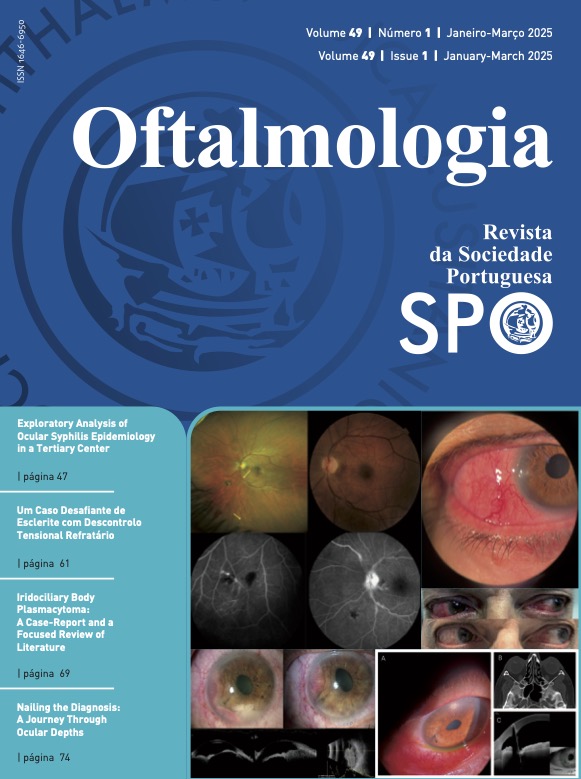Melanoma da Úvea em Portugal: Tendências de Incidência e Análise Geográfica
DOI:
https://doi.org/10.48560/rspo.33228Palavras-chave:
Incidência, Melanoma/epidemiologia, Neoplasias da Úvea/epidemiologia, PortugalResumo
INTRODUÇÃO: O melanoma da úvea (MU) é a malignidade intraocular mais comum nos adultos. Apesar do sucesso nos tratamentos locais, a sobrevida a longo prazo continua a ser um desafio e o diagnóstico precoce crucial. A compreensão das disparidades geográficas pode influenciar a vigilância da doença e o prognóstico. Este estudo tem como objetivo reportar as tendências nacionais e geográficas de incidência do MU em Portugal.MÉTODOS: Estudo prospetivo, observacional, realizado no Centro de Referência Nacional de MU entre Julho 2013 e Dezembro 2022. Taxas brutas de incidência e padronizadas para a idade foram calculadas, bem como a sobrevivência global (OS) e a sobrevida livre de doença (DSS). A análise COX avaliou o impacto das características tumorais e demográficas na sobrevivência.
RESULTADOS: Um total de 316 doentes foram incluídos. A idade média ao diagnóstico foi de 61,8±14,2 anos. A Administração Regional de Saúde (ARS) de Lisboa e Vale do Tejo foi a maior responsável pela referenciação (n=119, 37,7%). A taxa de incidência ajustada para a idade em Portugal foi de 2.4 casos por milhão de pessoas (95% CI: 2,1-2,8). As taxas brutas de incidência foram mais elevadas nos distritos litorais do centro (5,4 por milhão em Aveiro (95% CI: 3,3-7,5)) comparativamente aos distritos do sul (1,0 por milhão em Faro (95% CI: 0,2-1,7)). A análise geográfica demonstrou incidência mais elevada na ARS do Centro (4,0 por milhão). A sobrevivência cumulativa aos 5 anos foi de 84,6% (95% CI: 78,7-91,1). Não houve diferença estatística na OS (p=0,74) ou DSS (p=0,83) entre ARS. A análise de Cox revelou que a dimensão basal do tumor está significativamente associada a menor sobrevida (HR=1,33, p<0,001).
CONCLUSÃO: Este é o primeiro estudo a reportar a incidência nacional e geográfica de MU em Portugal. A incidência padronizada para a idade não revelou predileção de sexo e foi inferior comparativamente aos países da Europa do Norte. As taxas brutas de incidência foram superiores na costa central de Portugal, mas não houve diferença significativa na OS ou DSS entre ARS ou distritos. O diâmetro basal tumoral foi o único preditor da sobrevivência de MU para a população desta análise.
Downloads
Referências
Kaliki S, Shields CL. Uveal melanoma: relatively rare but deadly cancer. Eye. 2017;31:241–257
Damato EM, Damato BE. Detection and time to treatment of uveal melanoma in the United Kingdom: an evaluation of 2,384 patients. Ophthalmology 2012; 119(8): 1582–1589.
Naseripour M, et al. Global Incidence and Trend of Uveal Melanoma from 1943-2015: A Meta-Analysis. Asian Pac J Cancer Prev. 2023;5:1791-1801
Ghazawi FM, Darwich R, Le M, Rahme E, Zubarev A, Moreau L, Burnier JV, Sasseville D, Burnier MN, Litvinov IV. Uveal melanoma incidence trends in Canada: a national comprehensive population-based study. Br J Ophthalmol. 2019;0:1–5
Aronow ME, Topham AK, Singh AD. Uveal melanoma: 5 year update on incidence, treatment, and survival (SEER 1973–2013). Ocular Oncology and Pathology. 2018;4(3):145-151.
Shields CL, Kaliki S, Furuta M, Mashayekhi A, Shields JA. Clinical spectrum and prognosis of uveal melanoma based on age at presentation in 8,033 cases. Retina. 2012;32(7):1363–1372
Virgili G, Gatta G, Ciccolallo L, Capocaccia R, Biggeri A, EUROCARE Working Group et al. Incidence of uveal melanoma in Europe. Ophthalmology 2007; 114: 2309–2315.
Alfaar AS, Saad A, Wiedemann P, Rehak M. The epidemiology of uveal melanoma in Germany: a nationwide report of incidence and survival between 2009 and 2015. Graefes Arch Clin Exp Ophthalmol. 2022 May;260(5):1723-1731.
Andreoli MT, Mieler WF, Leiderman YI. Epidemiological trends in uveal melanoma. Br J Ophthalmol 2015; 99(11):1550–1553.
Beasley A, Preen D, McLenachan S, Gray E, Chen F. Incidence and mortality of uveal melanoma in Australia (1982–2014). Br J Ophthalmol. 2023;107:406–411.
Singh AD, Turell ME, Topham AK. Uveal melanoma: trends in incidence, treatment, and survival. Ophthalmology. 2011 Sep;118(9): 1881–5.
Baily C, O'Neill V, Dunne M, Cunningham M, Gullo G, Kennedy S, Walsh PM, Deady S, Horgan N. Uveal Melanoma in Ireland. Ocul Oncol Pathol. 2019 Apr;5(3):195-204.
Shields CL, Kaliki S, Furuta M, Mashayekhi A, Shields JA. Clinical spectrum and prognosis of uveal melanoma based on age at presentation in 8,033 cases. Retina. 2012;32(7):1363–1372
Xu Y, et al. Epidemiological Study of Uveal Melanoma from US Surveillance, Epidemiology, and End Results Program (2010–2015). Journal of Ophthalmology. 2020:1-8
Kaliki S, Shields CL, Shields JA. Uveal melanoma: estimating prognosis. Indian J Ophthalmol. 2015 Feb;63(2):93-102
Downloads
Publicado
Como Citar
Edição
Secção
Licença
Direitos de Autor (c) 2024 Revista Sociedade Portuguesa de Oftalmologia

Este trabalho encontra-se publicado com a Creative Commons Atribuição-NãoComercial 4.0.
Não se esqueça de fazer o download do ficheiro da Declaração de Responsabilidade Autoral e Autorização para Publicação e de Conflito de Interesses
O artigo apenas poderá ser submetido com esse dois documentos.
Para obter o ficheiro da Declaração de Responsabilidade Autoral, clique aqui
Para obter o ficheiro de Conflito de Interesses, clique aqui





